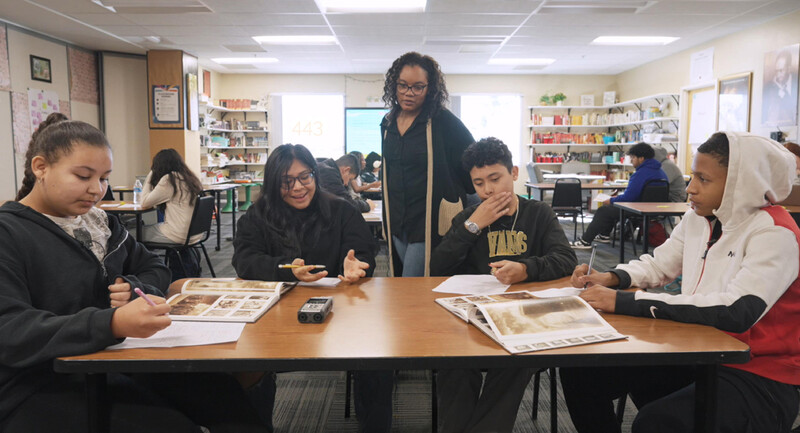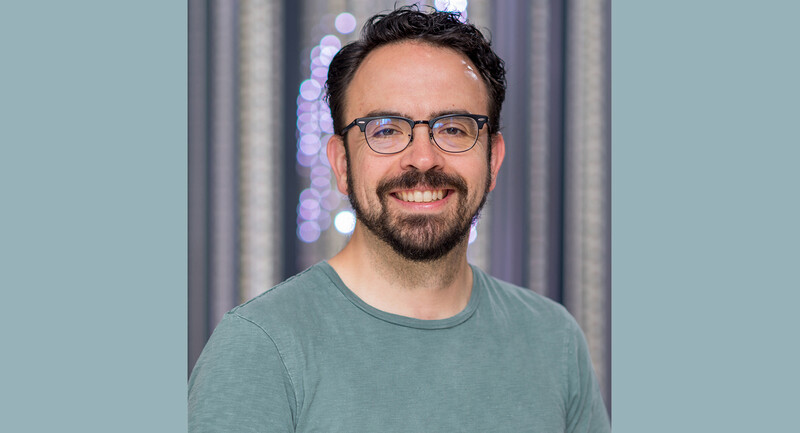All at once, the holograms rose above students' desks. Through a homemade Plexiglass projector held over an iPad video, one student produced a tiny, flitting hummingbird. "It's lit!" exclaimed another, who brought to life a crackling fireplace. It was another average day in Valerie Camille Jones's middle school classroom at Ron Clark Academy in Atlanta.
These were students' versions of Kimoyo bracelets from the record-breaking movie "Black Panther," worn by the characters of Wakanda to communicate with one another. But they weren't learning about film or literature. They were in math class, using scale factor, proportions, and a coordinate plane to create four trapezoids for 3-D images.
Math is still a subject that keeps many students up at night. But a positive attitude about the topic is one key to higher achievement, according to researchers at Stanford University. There have been pushes to move away from rote memorization, to make math more visual or teach it like a language, and to increase growth mindset and self-esteem—all in the name of countering a cultural mindset that often paints math as impossible for the average person.
Jones's solution is to incorporate her favorite TV shows, video games, and homemade music videos into almost every lesson and activity. Her boundless passion for the subject is visible in the videos she films for her YouTube channel and in the fashion math rap she created for Old Navy's ONward! campaign. She strives to develop students' "math esteem," a phrase she recently trademarked.
"If you take what kids already love in the world and find a way of embedding what you need to teach into that, they'll remember it better," said Jones.
We asked a handful of educators who are shaking up math instruction to share their tips.
About the Experts
Figure
Figure
Figure
Figure
Figure
Figure
Reverse an age-old mindset.
Valerie: Math is always painted as a hard subject. Before kids even have a taste for it, that idea is psychologically put in their heads through media and movies and also at home. That's why I started a "math esteem" push and got the phrase trademarked. If you feel like you're open to math, you are going to solve that problem more successfully. So, 50 percent of every problem you're given is how you think about it, and 50 percent is actually doing it.
Lou: In the last 25 years, I've seen the same things everywhere I've taught: Students are under-engaged and involved in bland activities like doing worksheets or listening to teacher lectures. How can we organize math experiences that are different? We've been creating InspireMath academies—sustainable programs that communities learn to own and operate. It might be a STEM program, a reinvented calculus program, or turning algebra into mathematics modeling using robotics and graphic calculators. We look at student needs and school districts, and then we customize experiences that reshape how math is taught.
Share your own passion.
Matthew: My belief is that mathematics itself is a very beautiful, joyful subject, but we as mathematics teachers need to do a better job of sharing our passion. Many times, I hear students will think or say out loud, "If my own teacher is not excited about the learning we're doing, why am I supposed to be excited?" Whereas in many science, technology, and engineering classrooms, teachers are openly excited about the work.
Kimberly: My classroom is "mathlicious." "Licious" means pleasing, and I want my classroom to be the best fraction of a kid's day. A lot of students don't have good experiences in school, especially the ones coming to me. I always tell them: Just give me a minute to rotate that negative parabola on your face into a positive one. Don't be discouraged about how you enter. Be encouraged about how you exit.
Use the media students already love.
Matthew: I asked if I could make my own show [on a local TV station] as a way to inform parents about all the great things happening in our district. We started taking popular songs and changing the lyrics to relate to mathematical concepts: "Polygons Are Awesome" (based on The LEGO Movie hit "Everything Is Awesome" by Tegan and Sara) and "I Really Like Math" (based on Carly Rae Jepsen's "I Really Like You"). Though the TV show ended, I have students at all different levels still involved in writing songs and videotaping a few times a year through after-school clubs and film editing courses. It's a way to change the culture of learning mathematics.
Valerie: I love movies and television and found it easier to connect standards to movie themes: The Avengers, A Wrinkle in Time, Black Panther. We also use a lot of board and video games that relate to math concepts. Some of my favorites are A Tangled Web, which uses circle theorems and angle concepts, and a math/English game called DimensionU, which is sort of like Fortnite with math. I can pick which Common Core standards I want students to address.
Change up your language.
Kimberly: No matter what you're teaching, it's the presentation. I turn every day into a name that catches their attention for a warm-up activity. Monday is "Mathoggle" Monday—like Boggle but with integers. On "Tweakin' Tangeo" Tuesday, they get a tangram puzzle. On "Wuzzle What's Up" Wednesday, we discuss what's up in their life while figuring out a math puzzle. On "Thirsty" Thursday, we roll a 10-sided dice and use combinations of the first five numbers to create the day's date. And on "Fridab" Friday, we talk about the good things that happened that week and create a four-line poem about a math concept. We "rap it up" with freestyle about what we learned.
Don't underestimate the power of visuals.
Matthew: Math helps explain the whole world that we live in. Giving students information, data, and pictures and coming up with questions they are interested in exploring together begins a more engaging learning process. One recent model lesson I gave was a picture of a roof with 457 solar panels. We began by discussing all the things we noticed and what we wondered: How much energy does each solar panel create? How many solar panels are there? Think, pair, share to come up with an estimate. I'm not concerned with what the correct answer is—I want to hear thought process and reasoning.
Use technology to encourage engagement.
Valerie: Kids come into class with iPads, so we funnel lessons through a free website called Classflow with PowerPoint slides and projection. I can send what's on my board directly to the kids' iPad and see every students' answer as a pie chart or a bar graph. Kids love it because they're able to contribute without waiting to be called on, and I can hide names so that students who are afraid to get it wrong don't have that shame. But I encourage them to make mistakes.
Make math culturally responsive.
Lou: For the last 20 years, I've been doing research on culturally responsive teaching with one of my colleagues in Connecticut. How do we teach math in ways that engage students and help them think about their communities? There are three basic ideas for culturally responsive teaching:
- Creating high expectations for all students;
- Developing cultural competence and teaching math in ways that are not divorced from who students are, and;
- Teaching math for a purpose. What if you use math to alleviate the conditions of suffering? To question inequity? We do this by changing the kinds of tasks we put in front or children—tasks that have them focus on mathematizing issues like wealth inequality, food deserts, housing, communities, and justice.
We've created a culturally relevant rubric for assessing mathematics tasks (which is free to download). We help teachers take tasks they already do and filter and transform them through the rubric's lens: more problem-solving; more culture and community connections; and more critical, open-ended questions.
Connect to the real world.
Darnell: One of the first things we do in our [Algebra Nation's online learning platform] videos is provide real-world examples. We have five or six study experts, including me, who teach the same concepts, and students can pick whom they want to watch. I had an interaction at the end of the school year with a student who remembered the first video he watched, a mathematical expression problem about Mario and Luigi buying video games. He asked me, "Did you ever buy the things you said you were going to buy in the video?" Students have probably bought a video game or understand the concept, so it sticks in their head. We want it to be engaging in a way that reminds them of real life.
Keep it simple.
Corey: We've made it seem like teaching in ways that are conceptual and engaging and relevant to children is a big deal, like you need to write your own curriculum. It's the small things you do with any curriculum you have: Provide kids opportunities to ask why, let them have access to tools and talk to each other, let them wrestle with a problem. We haven't done a good job of talking about how you can do those things no matter what curriculum or assessments you use.
Matthew: Massachusetts has a very extensive list of standards for every grade level for state tests. If we were to cover every single standard, we would not go in depth into any single subject. So, at each grade level, we pick the five most important "power standards" [here's an example from a neighboring district]—the big ideas we've talked about—that every student will need to know and understand. We focus more on conceptual understanding rather than procedural knowledge: We want students to understand why the math is the way that it is.
Give students the reins.
Corey: You can flip the curriculum around so that kids are the ones doing the creating and sense-making. That might mean that they're writing a song, or teaching a younger student, or developing artwork using the math they've learned. Fun and creativity are important, but the kids need to be the ones who own the math in all activities.
Valerie: In 2013–14, I had a project with 7th graders where I was trying to get them to understand the importance of math in everything. I asked them to make real-world videos explaining the math concept in a way that appeals to their generation. They did their own directing, writing, and filming on their cell phones. The only thing I did was tell them whether their answers were right or wrong. We submitted the videos to the Math Counts competition, and one group of four boys won the competition and got a $1,000 scholarship for college. Two of those boys hadn't been too successful before, and their whole lives changed because of this competition. We even got invited to the White House to meet President Obama and Vice President Biden. They're all going to college this year.
Editor's note: Responses have been edited lightly for length and clarity.







